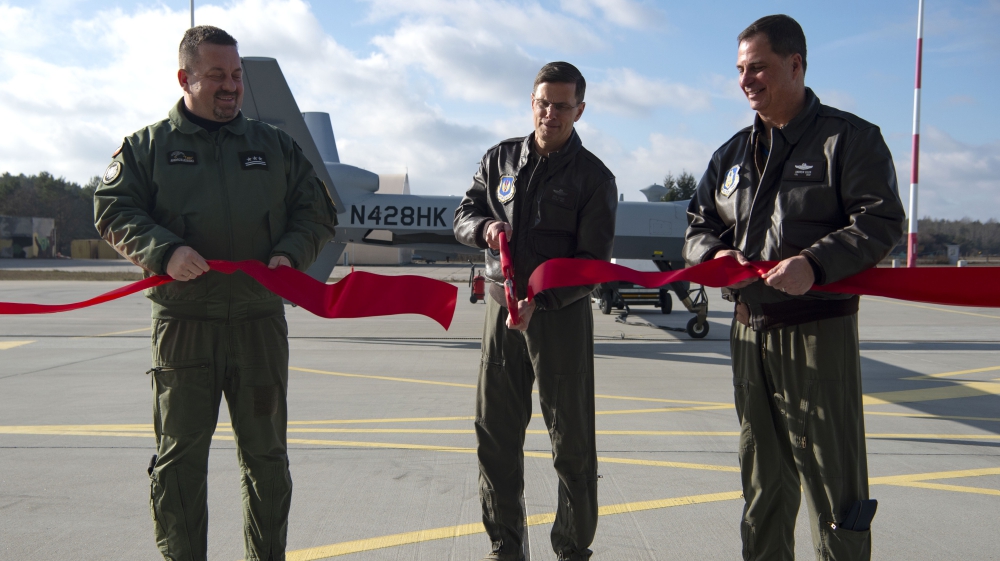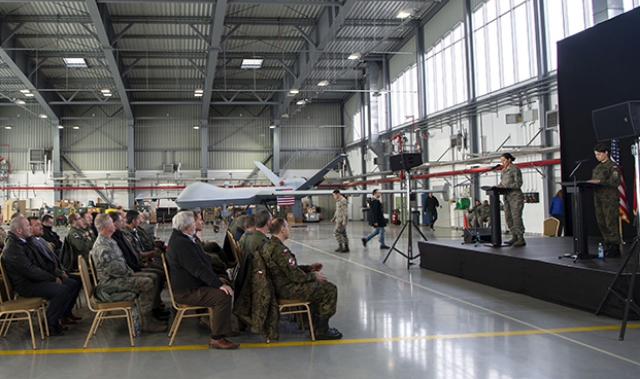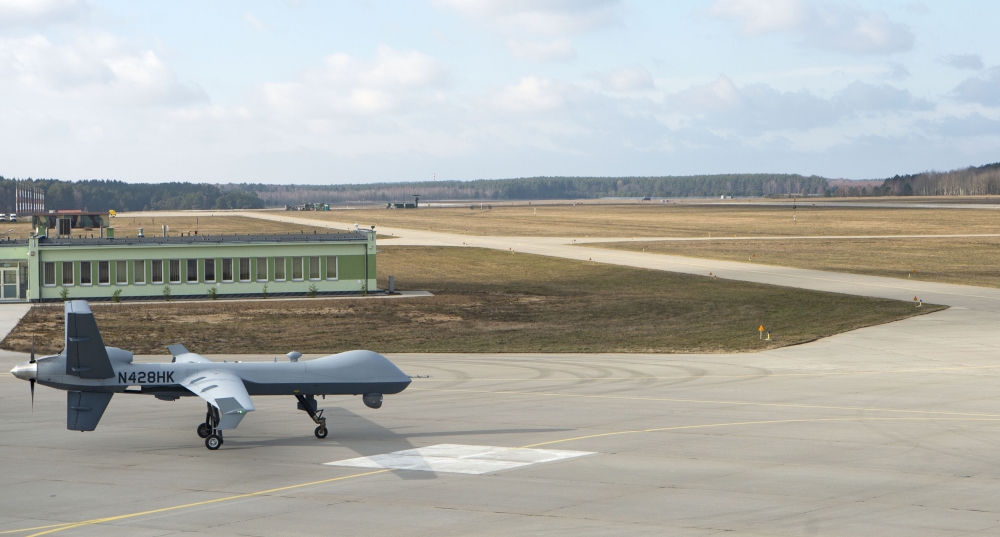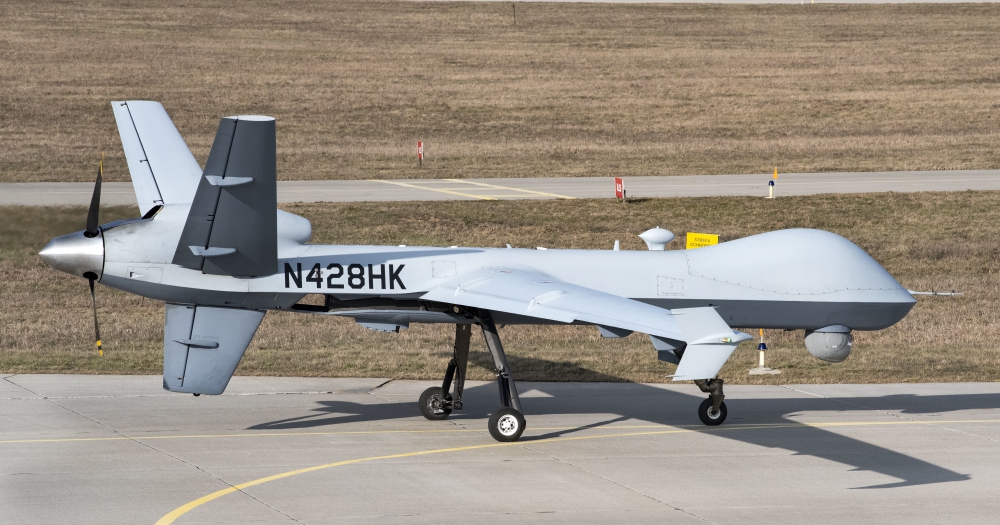
U.S. Air Force Brig. Gen. Greg Semmel, Air National Guard assistant to the commander in United States Air Forces in Europe, Air Forces in Africa, center, cuts a ribbon with the help of Polish air force Col. Lukasz Andrzejewski,12th Unmanned Aerial Vehicle base commander, Miroslawiec Air Base, left, and U.S. Air Force Col. Andrew Eiler, 52nd Expeditionary Operations Group Detachment 2 commander, right, during a ceremony at Miroslawiec AB, March 1, 2019.
The US Air Force (USAF) has achieved the full operational capability of the MQ-9 remotely piloted aircraft (RPA) detachment at Miroslawiec Air Base, Poland. The event was marked by a ceremony at Miroslawiec Air Base, Poland, March 1, 2019. attended by US airmen from Headquarters US Air Forces in Europe, 52nd Fighter Wing, Spangdahlem Air Base, Germany and the 118th Wing, Tennessee Air National Guard.
The event marked the opening of new facilities at the detachment and celebrated the 52nd EOG reaching full operational capability.
Some of the facilities recently opened included secure processing centers, a large aircraft maintenance shelter, communications infrastructure and living dormitories for personnel assigned there.
“In addition to the completion of these projects, another important change is the remotely piloted aircraft here are now operated by both contractors and U.S. military personnel,” said U.S. Air Force Brig. Gen. Greg Semmel, Air National Guard assistant to the commander, United States Air Forces in Europe-Air Forces Africa. “This flexibility allows for the addition of new missions, and having U.S. military personnel expands the variety of missions we can accomplish.”

U.S. Air Force, Polish air force and contracted employees attend a ribbon-cutting ceremony at Miroslawiec Air Base, Poland, March 1, 2019.
Contractors and U.S. military now share control during operations such as the takeoff, mission, and recovery of the aircraft. Currently, the Air National Guard is the U.S. military presence operating the remotely piloted MQ-9 Reaper aircraft there, providing intelligence, surveillance and reconnaissance in support of U.S. foreign policy security. The currently configured unarmed aircraft provides valuable force protection data to the U.S. and international partners.
“I would like to express my gratitude to all of our U.S. friends for all you have done so far with the MQ-9 operation to provide for European security,” said Polish air force Col. Lukasz Andrzejewski, 12th Unmanned Aerial Vehicle base commander, Miroslawiec AB. “We appreciate all the support, involvement, openness and kindness you give us every day.”

A remotely piloted MQ-9 Reaper taxis toward the runway shortly after a ribbon-cutting ceremony at Miroslawiec Air Base, Poland
Det. 2 works closely with the Polish air force on its mission of operating the MQ-9. Many U.S. personnel assigned there have developed strong relationships with the partnered nation.
“They all welcomed us into the community, they welcomed us into their restaurants, into their shops and into their homes,” said U.S. Air Force Col. Andrew Eiler, 52nd EOG Det. 2 commander, “We were neighbors, but became friends and family. I am very proud of the partnership and the capability that we’ve built.”
Semmel said the U.S. and Poland have had a long-standing partnership to address issues on regional and global security. The mission at Det. 2 further facilitates this partnership by increasing overall readiness, honing the ability to operate in a rapidly changing environment, and by building upon the enduring and strategic relationship between the two nations.
“Over the years our proven partnership with Poland has been built upon shared values, experience and vision,” said Semmel. “As our environment continues to change, forward locations like Det. 2 become that much more critical at enhancing our ability to safeguard European security.”
The new, fully operational USAF MQ-9 base in Poland will begin flying over the Baltics to give the US and NATO better early warning, as well as a better understanding of the potential battlespace, as the alliance pushes to further deter Russia, the head of US Air Forces in Europe said.
Gen. Tod Wolters, commander of USAFE and commander of Allied Air Command, told Air Force Magazine during an interview at AWS that the purpose of the new MQ-9 detachment is to provide better indications and warnings, something that all NATO countries have been asking for.
“With an MQ-9 asset in region, as you can well imagine distance that it flies and locale that it happens to be in, we should be able to improve our understanding of the battlespace in the vicinity of Poland plus the Baltics,” Wolters said. “That’s the whole purpose, to improve our indications and warnings so that if tasked we can respond quicker than we ever have in the past, and the MQ-9 addition will do exactly that.”
USAF and the Polish air force on March 1 held a ribbon-cutting ceremony for the new detachment at Miroslawiec AB, Poland. The 52nd Expeditionary Operations Group Detachment 2 will fly alongside the Polish air force’s 12th Unmanned Aerial Vehicle Base with unarmed MQ-9s. The base has a new maintenance shelter, secure processing centers, communications infrastructure, and dormitories, according to a USAFE release.
Wolters said this new base helps address NATO’s constant need of improved indications and warnings, along with command and control to improve the ability to “neutralize a potential adversary.”
“That’s something the nations ask from the US, and something the nations ask from all of the other countries.”
The Air Force, and broader US military, have been increasing the funding for the European Deterrence Initiative, which goes to military construction at bases across the continent and to improved readiness exercises.
The MQ-9s in Poland will begin flying in the “vicinity of the Baltics” and that’s an “improvement in readiness right there” by putting “more eyes on the potential battlespace,” Wolters said. He wouldn’t specifically say how many orbits the aircraft would fly, just that “more is better.”
The goal with an improved posture in the region is to be in a position where “nobody will ever consider violating the sovereign skies, lands, and seas of NATO countries in the region,” he said.
Photos: USAF / Senior Airman Preston Cherry
Sources: USAF Press Release; Air Force Magazine

